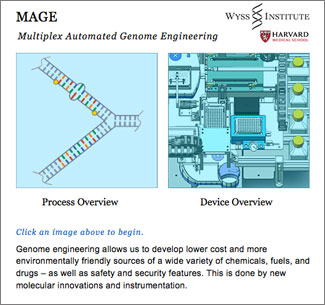Narrated by George Church

[Optimized to work with Firefox, Chrome, and Safari.]
MAGE is a technology that is capable of taking a population of cells and adding, deleting, and replacing DNA sequences at very specific target locations within the cellular genome. Moreover, MAGE can efficiently edit multiple DNA sequences in parallel instead of targeting one gene at a time. This allows for the creation of cell populations that have a great deal of genomic diversity.
In other words, you can think of MAGE as an instrument of accelerated directed evolution — it is able to harness the power of natural selection to evolve properties not found in nature.
MAGE, which stands for Multiplex Automated Genome Engineering, is both a process and a device. As a process, it takes advantage of recent developments in genome engineering that include a wide variety of environmentally friendly chemicals, fuels, and drugs. As a device, MAGE automates much of the work involved in gene manipulation by taking advantage of recent innovations and, as a result, allows making genome changes at lower cost.
A significant advantage MAGE offers is the speed at which it works. In an early test of the device, Wyss researchers were able to create, in three days, a variation of E. coli that could produce the pigment lycopene. Using the traditional “tool box,” this work would have taken a biotech company months or even years to complete.
The self-directed animation shown on this page illustrates both the MAGE process and the device itself. It is narrated by Wyss Core Faculty member George Church, Ph.D.